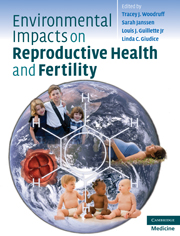Book contents
- Environmental Impacts on Reproductive Health and Fertility
- Environmental Impacts on Reproductive Health and Fertility
- Copyright page
- Contents
- Contributors
- Preface
- Acknowledgments
- 1. Introduction
- 2. Environmental contaminants and exposure
- 3. Development and maturation of the normal female reproductive system
- 4 Development and maturation of the normal male reproductive system
- 5 Modern genetics of reproductive biology
- 6. Mechanisms of endocrine disruption
- 7. Developmental exposures and implications for early and latent disease
- 8 Wildlife as sentinels of environmental impacts on reproductive health and fertility
- 9 Environmental contaminants and effects on timing and progression of human pubertal development
- 10 Environmental contaminants and impacts on healthy and successful pregnancies
- 11 Environmental contaminants and reproductive and fertility effects in the male
- 12. Environmental contaminants, female reproductive health and fertility
- 13 Environmental contaminants and related systems that have implications for reproduction
- 14 Environmental contaminants and cancers of the reproductive tract
- 15 Communicating with patients and the public about environmental exposures and reproductive risk
- 16 Interpreting science in the policy context
- 17 Conclusions – what does all this mean, and where are we going?
- Index
15 - Communicating with patients and the public about environmental exposures and reproductive risk
Published online by Cambridge University Press: 23 February 2010
- Environmental Impacts on Reproductive Health and Fertility
- Environmental Impacts on Reproductive Health and Fertility
- Copyright page
- Contents
- Contributors
- Preface
- Acknowledgments
- 1. Introduction
- 2. Environmental contaminants and exposure
- 3. Development and maturation of the normal female reproductive system
- 4 Development and maturation of the normal male reproductive system
- 5 Modern genetics of reproductive biology
- 6. Mechanisms of endocrine disruption
- 7. Developmental exposures and implications for early and latent disease
- 8 Wildlife as sentinels of environmental impacts on reproductive health and fertility
- 9 Environmental contaminants and effects on timing and progression of human pubertal development
- 10 Environmental contaminants and impacts on healthy and successful pregnancies
- 11 Environmental contaminants and reproductive and fertility effects in the male
- 12. Environmental contaminants, female reproductive health and fertility
- 13 Environmental contaminants and related systems that have implications for reproduction
- 14 Environmental contaminants and cancers of the reproductive tract
- 15 Communicating with patients and the public about environmental exposures and reproductive risk
- 16 Interpreting science in the policy context
- 17 Conclusions – what does all this mean, and where are we going?
- Index
Summary
Keywords
- Type
- Chapter
- Information
- Publisher: Cambridge University PressPrint publication year: 2010
- 1
- Cited by

